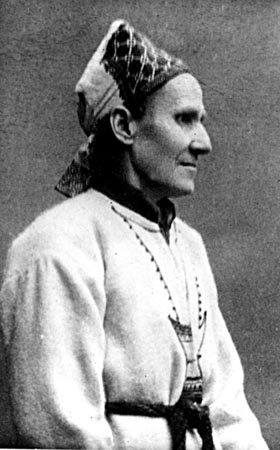Izhorians
Izhorians (also referred to as Ingrians, distinct from the Ingrian Finns) are a Finno-Ugric ethnic group native to the Ingria region of Russia. They are one of the indigenous peoples of the area, with their own unique language, Izhorian, which belongs to the Finno-Ugric languages family, closely related to Finnish and Estonian. Despite their cultural and linguistic ties to other Finno-Ugric peoples, the Izhorians have a distinct identity shaped by their historical experiences, geographical location, and cultural practices.
History[edit | edit source]
The history of the Izhorians is closely intertwined with the history of the Ingria region, which has been influenced by various powers over the centuries, including the Swedish Empire and the Russian Empire. The area known as Ingria has been a contested space due to its strategic location between Russia and Sweden, leading to its diverse cultural and ethnic makeup.
In the early 17th century, during the time of the Swedish Empire's control over Ingria, the Izhorians, along with other local peoples, faced efforts of Swedification. However, with the Treaty of Stolbovo in 1617, Ingria was ceded to Russia, marking the beginning of a long period of Russification policies that aimed to integrate the Izhorians and other local ethnic groups into the Russian cultural and linguistic sphere.
Despite these pressures, the Izhorians have managed to preserve their language, traditions, and cultural identity. However, like many minority groups in Russia, they have faced challenges related to cultural preservation and the erosion of their traditional way of life due to modernization and the centralizing policies of the Russian state.
Language[edit | edit source]
The Izhorian language is a critical component of the Izhorian identity. It is a member of the Finno-Ugric language family and is most closely related to the Votic language, with which it forms the Ingrian subgroup. The language has several dialects but has been in decline due to the influence of Russian, leading to concerns about its survival. Efforts have been made to revitalize the language, including educational programs and the publication of materials in Izhorian.
Culture[edit | edit source]
Izhorian culture is marked by its agricultural traditions, folklore, and religious practices. The Izhorians have historically been Orthodox Christians, a faith that was introduced to the region after the Russian conquest. Their religious practices often blend Orthodox Christianity with older, pre-Christian beliefs and rituals, reflecting the syncretic nature of their cultural identity.
Traditional Izhorian folklore includes a rich collection of myths, legends, and epic poems that are integral to their cultural heritage. These stories often feature themes of nature, the seasons, and the spiritual world, reflecting the deep connection the Izhorians have with their environment.
Demographics[edit | edit source]
Today, the number of Izhorians is small, with the population facing decline due to assimilation and the loss of language. According to the most recent censuses, there are only a few hundred to a few thousand Izhorians living in Russia, primarily in the Leningrad Oblast. The community faces challenges related to preserving their language and culture in the face of modernization and the dominant Russian cultural influence.
Conclusion[edit | edit source]
The Izhorians are a testament to the resilience of indigenous cultures in maintaining their identity and traditions despite centuries of external pressures. Their efforts to preserve their language and culture highlight the importance of cultural diversity and the challenges faced by minority groups in a rapidly changing world.
Navigation: Wellness - Encyclopedia - Health topics - Disease Index - Drugs - World Directory - Gray's Anatomy - Keto diet - Recipes
Search WikiMD
Ad.Tired of being Overweight? Try W8MD's physician weight loss program.
Semaglutide (Ozempic / Wegovy and Tirzepatide (Mounjaro / Zepbound) available.
Advertise on WikiMD
WikiMD is not a substitute for professional medical advice. See full disclaimer.
Credits:Most images are courtesy of Wikimedia commons, and templates Wikipedia, licensed under CC BY SA or similar.Contributors: Prab R. Tumpati, MD




